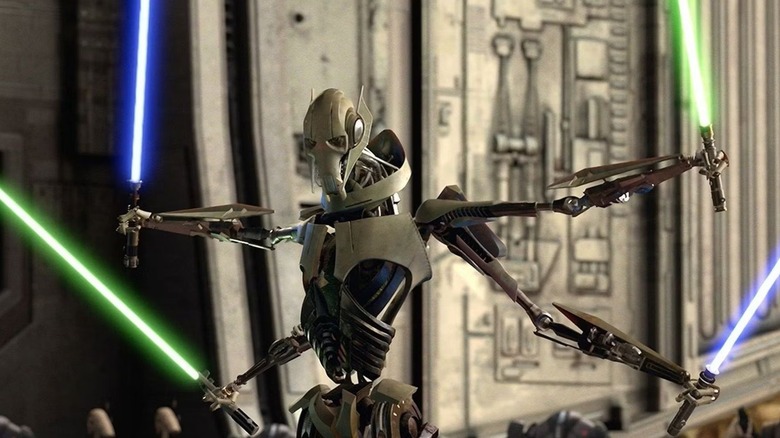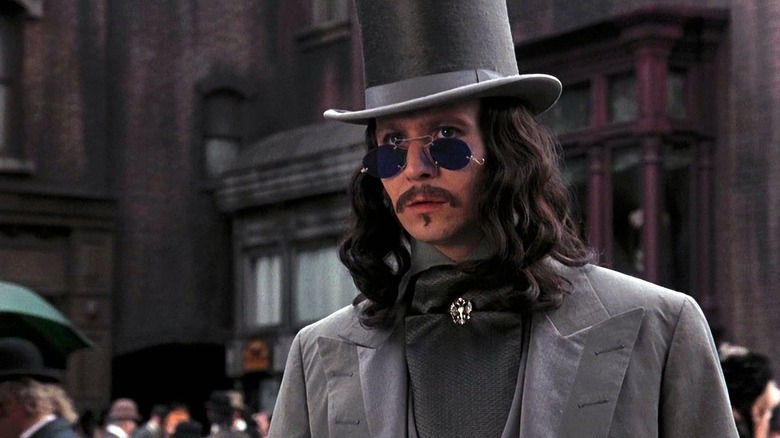“Star Wars” is full of fascinating, enigmatic villains, most of them get barely any dialogue, not to mention their background or backstory defined — within the films at the very least. Whether or not it is Darth Vader being launched as only a tall, menacing man clad in darkish, robotic armor, or Boba Fett’s silent, placing go well with of armor, these antagonists work due to how little we all know of them, and the way memorable their designs are.
That is very true within the prequel trilogy, the place we get characters like Darth Maul, who’s simply evil incarnate, an ideal design. Although maybe not as well-liked, Basic Grievous’ personal character design is simply as efficient. He is a villain who’s immediately memorable and placing, his cybernetic exterior and organic organs making him quite mysterious and alluring.
Grievous, like most issues “Star Wars,” went by way of many modifications earlier than making his debut, with George Lucas even briefly considering making the character Darth Maul in disguise. The overall was first launched within the 2003 animated micro-series “Clone Wars” by Genndy Tartakovsky, the place he was voiced by John DiMaggio and Richard McGonagle, earlier than making his massive display screen debut in “Star Wars: Episode III — Revenge of the Sith.” In that movie, Grievous was voiced by sound editor and voice actor Matthew Wooden, who would go on to reprise the position within the cartoon collection “The Clone Wars” (the place he additionally voices the battle droids and plenty of others).
However earlier than Wooden grew to become the voice of Grievous, the asthmatic cybernetic villain was nearly portrayed in “Revenge of the Sith” by none apart from Oscar-winner Gary Oldman. As soon as, whereas showing on the “Happy Sad Confused” podcast, Oldman stated he even recorded some traces for the character, directed by Lucas himself. So what went mistaken? In response to Oldman, “What occurred was one thing to do with union stuff and non-union stuff,” including that he did not need to be “the poster boy for breaking union guidelines.”
George Lucas’ historical past with unions and guilds is sophisticated
The explanation Oldman was unable to voice Grievous in “Revenge of the Sith” needed to do with the movie being a non-SAG shoot that passed off in England and Australia — as all “Star Wars” films have. There’s a regulation throughout the Display screen Actors Guild generally known as International Rule One, which ensures members retain their full union protections even when they work overseas. Although Lucasfilm requested for particular permission to have Oldman participate in a non-union manufacturing, the actor ended up having to take a move on the movie.
That is removed from the primary time George Lucas had difficulties with unions and guilds, with whom the director has had an extended, uneasy, and sophisticated historical past. It began after the discharge of “Star Wars: Episode V — The Empire Strikes Again” in 1980, when Lucas very publicly left the Director’s Guild of America after a dispute concerning the usage of an on-screen director credit score. Although Lucas has obtained awards from the Producers Guild (of which he presumably continues to be a member), he’s additionally not technically a member of the WGA. As a substitute, the retired filmmaker is a “fi-core member,” which means he resigned his full membership to the writers’ union and as an alternative pays his dues and union contract advantages, however in any other case doesn’t need to observe any union guidelines, together with union strikes.
In 1981, Lucas even grew to become the very first individual to turn into a fi-core member of the WGA — though the listing quickly got here to incorporate different notable filmmakers corresponding to Francis Ford Coppola, Bob Gale, Robert Rodriguez, and Steven Soderbergh.
“Star Wars” is full of fascinating, enigmatic villains, most of them get barely any dialogue, not to mention their background or backstory defined — within the films at the very least. Whether or not it is Darth Vader being launched as only a tall, menacing man clad in darkish, robotic armor, or Boba Fett’s silent, placing go well with of armor, these antagonists work due to how little we all know of them, and the way memorable their designs are.
That is very true within the prequel trilogy, the place we get characters like Darth Maul, who’s simply evil incarnate, an ideal design. Although maybe not as well-liked, Basic Grievous’ personal character design is simply as efficient. He is a villain who’s immediately memorable and placing, his cybernetic exterior and organic organs making him quite mysterious and alluring.
Grievous, like most issues “Star Wars,” went by way of many modifications earlier than making his debut, with George Lucas even briefly considering making the character Darth Maul in disguise. The overall was first launched within the 2003 animated micro-series “Clone Wars” by Genndy Tartakovsky, the place he was voiced by John DiMaggio and Richard McGonagle, earlier than making his massive display screen debut in “Star Wars: Episode III — Revenge of the Sith.” In that movie, Grievous was voiced by sound editor and voice actor Matthew Wooden, who would go on to reprise the position within the cartoon collection “The Clone Wars” (the place he additionally voices the battle droids and plenty of others).
However earlier than Wooden grew to become the voice of Grievous, the asthmatic cybernetic villain was nearly portrayed in “Revenge of the Sith” by none apart from Oscar-winner Gary Oldman. As soon as, whereas showing on the “Happy Sad Confused” podcast, Oldman stated he even recorded some traces for the character, directed by Lucas himself. So what went mistaken? In response to Oldman, “What occurred was one thing to do with union stuff and non-union stuff,” including that he did not need to be “the poster boy for breaking union guidelines.”
George Lucas’ historical past with unions and guilds is sophisticated
The explanation Oldman was unable to voice Grievous in “Revenge of the Sith” needed to do with the movie being a non-SAG shoot that passed off in England and Australia — as all “Star Wars” films have. There’s a regulation throughout the Display screen Actors Guild generally known as International Rule One, which ensures members retain their full union protections even when they work overseas. Although Lucasfilm requested for particular permission to have Oldman participate in a non-union manufacturing, the actor ended up having to take a move on the movie.
That is removed from the primary time George Lucas had difficulties with unions and guilds, with whom the director has had an extended, uneasy, and sophisticated historical past. It began after the discharge of “Star Wars: Episode V — The Empire Strikes Again” in 1980, when Lucas very publicly left the Director’s Guild of America after a dispute concerning the usage of an on-screen director credit score. Although Lucas has obtained awards from the Producers Guild (of which he presumably continues to be a member), he’s additionally not technically a member of the WGA. As a substitute, the retired filmmaker is a “fi-core member,” which means he resigned his full membership to the writers’ union and as an alternative pays his dues and union contract advantages, however in any other case doesn’t need to observe any union guidelines, together with union strikes.
In 1981, Lucas even grew to become the very first individual to turn into a fi-core member of the WGA — though the listing quickly got here to incorporate different notable filmmakers corresponding to Francis Ford Coppola, Bob Gale, Robert Rodriguez, and Steven Soderbergh.





















